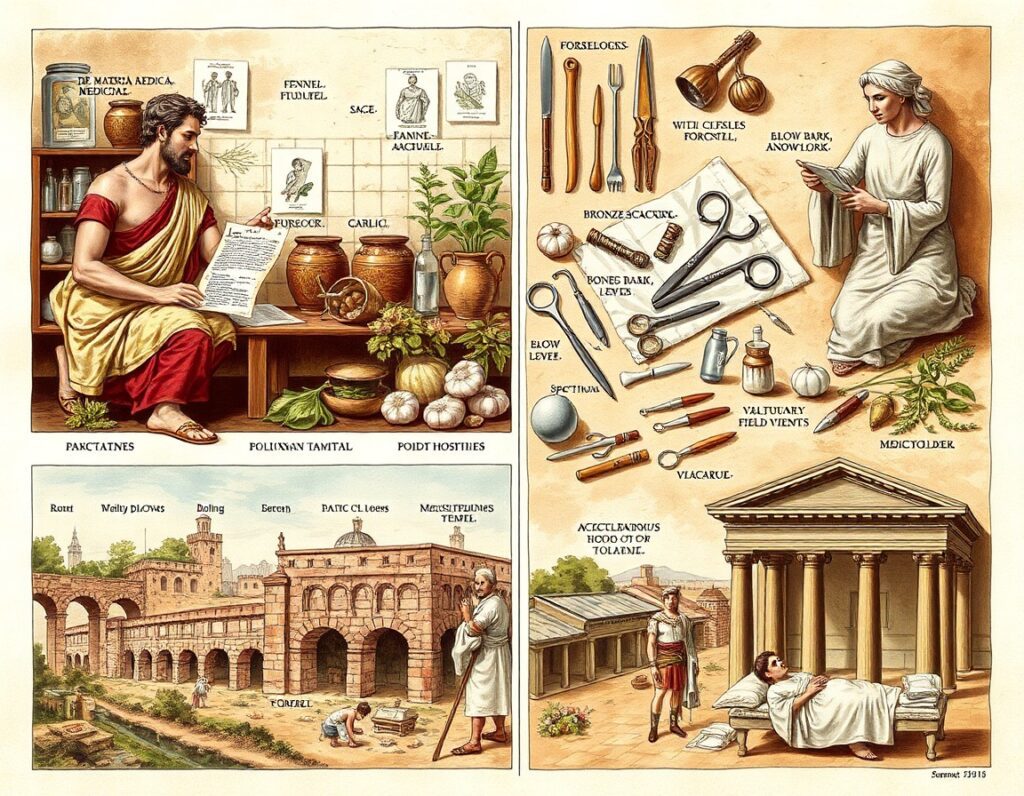Roman medicine is a fascinating mix of science and tradition, combining ancient medical knowledge with cultural practices. It is influenced by both practical observation and spiritual beliefs, and it has played a significant role in shaping the history of medicine.
By understanding the contributions of Roman medicine, we can gain insight into how early doctors effectively treated illnesses by combining herbal remedies with surgical innovations. These methods demonstrate an advanced understanding of health that has had a lasting impact on future generations.
In this article, we will explore:
- The Greek philosophical influences on Roman medical thought
- An in-depth examination of herbal remedies used to restore balance in the body
- The surgical tools and techniques developed by Roman practitioners, particularly in warfare
- The importance of public health infrastructure in preventing diseases
- The connection between spirituality and practical treatments
- The lessons that modern medicine can learn from these ancient practices
This exploration of The Science of Roman Medicine: From Herbal Remedies to Surgical Tools reveals how ancient knowledge still resonates in today’s health sciences.
The Greek Roots: Influences on Roman Medical Practices
Roman medicine drew heavily from Greek medical theories, integrating their systematic approach and philosophical insights. Central to this influence was the Hippocratic Corpus, a collection of texts that laid the foundation for clinical observation and ethical practice. The Greeks introduced the concept of disease as a natural phenomenon rather than a supernatural punishment, shifting the focus toward empirical diagnosis and treatment.
One cornerstone of this tradition was the four humors theory—an idea that health depended on balancing four bodily fluids: blood, phlegm, black bile, and yellow bile. Each humor corresponded to specific temperaments and physical qualities:
- Blood: associated with air and a sanguine temperament
- Phlegm: linked to water and a phlegmatic nature
- Black bile: connected to earth and melancholic traits
- Yellow bile: related to fire and a choleric disposition
Physicians diagnosed illness by identifying imbalances among these humors, then prescribed treatments aimed at restoring equilibrium through diet, herbal remedies, or procedures like bloodletting.
Key personalities who shaped Roman medical knowledge include Galen and Dioscorides. Galen’s extensive anatomical studies, based primarily on animal dissection, refined understanding of physiology and pathology. His writings dominated medical thought for centuries. Dioscorides authored De Materia Medica, an authoritative herbal pharmacopoeia that cataloged hundreds of plants with medicinal uses—many of which remained standard references well into the Renaissance.
These Greek foundations established a framework that Roman practitioners adapted, blending empirical observation with practical treatments suited to their environment and culture.

Healing Herbs: A Deep Dive into Roman Herbal Remedies
Roman medicine heavily relied on herbal remedies, utilizing a wide range of plants for healing purposes. This approach combined practical knowledge gained through experience with traditional beliefs passed down through generations.
The ancient Greeks had a significant influence on Roman herbal medicine, particularly through the works of Hippocrates and Galen. However, it was the Roman physicians themselves who expanded upon this foundation, incorporating local flora and adapting treatments to suit their patients’ needs.
One of the most important sources of information about Roman herbal medicine is De Materia Medica, a comprehensive text written by Dioscorides in the first century AD. In this work, Dioscorides documented hundreds of plants and their medicinal properties based on his observations during travels throughout the Mediterranean region.
Key Herbs Used in Roman Medicine
Here are some key herbs mentioned in De Materia Medica that were commonly used by Romans:
- Fennel: Valued for its diuretic and soothing properties, fennel was commonly prescribed for painful urination and digestive discomfort. Its seeds were often brewed into teas to relieve bladder issues.
- Sage: Known for its antiseptic qualities, sage was applied to wounds and inflammations. Romans used it to treat sore throats and mouth ulcers by gargling infusions.
- Garlic: Beyond culinary use, garlic served as a potent antimicrobial agent. It was believed to boost immunity and was used against respiratory infections and parasitic worms.
- Willow bark: This bark contained salicin, a chemical precursor to modern aspirin. Romans employed willow bark extracts as a pain reliever and anti-inflammatory for headaches, fevers, and muscle pain.
- Aloe: Recognized for its healing effects on skin injuries, aloe vera gel was applied topically to promote wound healing and soothe burns.
- Silphium: An extinct but highly prized plant, silphium had multiple medicinal applications including digestive aid and contraceptive properties. Its rarity made it one of the most valuable herbs in Roman trade.
The Role of Herbs in Roman Medical Philosophy
The selection of herbs reflected Roman physicians’ intent to address symptoms naturally while aiming to restore balance within the body. Each plant’s unique active compounds played a targeted role in alleviating common health issues encountered across the empire—from urinary troubles to inflammation and infection.
This detailed botanical inventory illustrates how deeply herbal knowledge was woven into Roman medical practice, blending observation with practical treatment strategies. Such reliance on natural substances set the stage for future pharmacological exploration.
The Philosophy Behind Roman Herbal Treatments
Roman medicine focused heavily on balancing humors—the four bodily fluids believed to govern health: blood, phlegm, black bile, and yellow bile. Illness was seen as an imbalance among these humors. Herbal remedies were crafted to restore this equilibrium by adjusting the body’s internal environment.
Central to this approach was the concept of natural heat, which referred to the body’s inherent warmth essential for life and healing. Plants and treatments were classified by their perceived qualities of heat or coldness, dryness or moisture. Healing involved applying substances with opposite properties to the affected area or condition. For example:
- A fever (excess heat) would be treated with cooling herbs like mint or cucumber.
- Cold-related ailments might be countered with warming herbs such as mustard or garlic.
This principle of opposites in treatment allowed Roman physicians to tailor therapies precisely, aiming to rebalance the patient’s natural state rather than just suppress symptoms.
The integration of humoral theory with herbal pharmacology shaped much of Roman medical practice. This philosophy underscored a holistic view, where health depended on harmony within the body and between the patient and nature—a foundational idea in The Science of Roman Medicine: From Herbal Remedies to Surgical Tools.

Surgical Advancements in Ancient Rome: Tools and Techniques
Roman surgeons developed an impressive range of specialized instruments that laid the groundwork for modern surgical practice. These tools were carefully designed to address specific medical needs with precision and efficiency.
1. Scalpels
Essential for making precise incisions, Roman scalpels came in various shapes and sizes, crafted from bronze or iron. Their sharpness allowed surgeons to perform delicate operations with minimal tissue damage.
2. Bone Levers
Used to manipulate or remove bone fragments, these tools were crucial in treating fractures or extracting foreign objects lodged within the skull. Bone levers provided leverage without excessive force, reducing patient trauma.
3. Forceps
Versatile instruments employed to grasp, hold, or extract tissues and objects. Roman forceps varied widely—from those designed for opening fetal skulls during complicated births to others used in wound care or removing debris.
4. Specula
Instruments such as vaginal and rectal specula enabled doctors to inspect internal cavities directly. This advancement improved diagnosis and treatment of uterine and bowel disorders by providing visual access previously unavailable.
Crafted with attention to ergonomic design and functionality, these surgical tools reflect Roman ingenuity in addressing complex medical challenges. The variety of instruments indicates a sophisticated understanding of anatomy and procedural requirements despite cultural limitations on human dissection.
This toolkit enabled surgeons not only to treat battlefield injuries but also to perform routine medical interventions, marking a significant leap in the practical application of surgical science.
Innovative Surgical Practices in Ancient Rome
Roman battlefield surgery demonstrated remarkable innovation, especially considering the limited medical knowledge of the time. Military medics faced urgent injuries requiring swift and effective treatment to save lives and return soldiers to combat readiness.
Key practices included:
Early sterilization techniques: Instruments were often boiled in water before use. This practice reduced infection risks, a critical advancement long before germ theory emerged. Boiling surgical tools such as scalpels, forceps, and cautery irons helped maintain cleanliness amid harsh battlefield conditions.
Pain management: Opium and scopolamine were employed as analgesics, easing patient suffering during surgeries like wound cleaning or amputations. These substances represent some of the earliest pharmacological efforts to control pain.
Field hospitals (valetudinaria): Makeshift medical stations close to battle zones allowed prompt surgical intervention. Surgeons performed procedures including setting broken bones, removing arrows or shrapnel, and treating severe wounds.
Surgical precision: Techniques such as trepanation (drilling skull holes) were used to relieve pressure from head injuries. Knowledge of anatomy gleaned from animal dissections guided these delicate operations.
This combination of practical sterilization methods, pain relief strategies, and organized battlefield care highlights Roman military medicine’s commitment to improving survival rates under extreme circumstances. The legacy of these practices influenced surgical standards well beyond antiquity, including aspects such as surgical site infection prevention which remains a critical focus in modern medicine.

Public Health Infrastructure: The Unsung Hero of Roman Medicine
Roman medicine went beyond just treating individual patients; it had a wider public health strategy that focused on preventing diseases through impressive engineering feats.
The Impact of Aqueducts on Hygiene
The advanced aqueducts were a key part of this strategy. They transported fresh water over long distances, ensuring that cities and baths had access to clean water essential for maintaining hygiene. This innovation significantly decreased the occurrence of waterborne illnesses and supported daily cleanliness practices among the population.
The Role of Sewage Systems in Disease Control
Another crucial aspect was the development of efficient sewage systems. These systems were designed to remove waste effectively from urban areas, using complex underground channels to carry sewage away from living spaces. By limiting exposure to harmful pathogens and controlling odors that could attract disease-carrying pests, these sewage systems represented one of the earliest large-scale urban sanitation projects in history.
Public Baths and Valetudinaria: Promoting Cleanliness and Specialized Care
Public baths played a vital role as communal centers for hygiene and social interaction, reinforcing cleanliness as a public health priority. Moreover, purpose-built hospitals known as valetudinaria catered mainly to soldiers and slaves, providing specialized care that combined medical treatments with sanitary environments.
The Connection Between Environmental Health and Illness Prevention
Roman engineers recognized that maintaining environmental health was crucial in preventing illness. Their investments in infrastructure, such as aqueducts and sewage systems, worked hand in hand with the medical practices discussed earlier in The Science of Roman Medicine: From Herbal Remedies to Surgical Tools, creating a comprehensive approach to health that integrated both prevention and treatment methods.
This emphasis on public health engineering laid the groundwork for more modern concepts of sanitation and urban planning related to medicine.
Spirituality Meets Science: The Duality of Roman Medical Beliefs
Roman medicine did not rely solely on empirical observation and herbal remedies. Spiritual healing played a crucial role, often working hand-in-hand with scientific methods. The Romans believed that health was influenced by both physical and divine forces. This dual approach shaped their medical practices significantly.
The Role of Aesculapius in Roman Medicine
The god Aesculapius, revered as the deity of healing and medicine, held a central place in Roman medical culture. Temples dedicated to Aesculapius served as healing centers where patients sought divine intervention alongside practical treatment. These temples functioned as early hospitals where priests performed rituals, offered prayers, and sometimes administered herbal medicines.
Spiritual Practices in Healing
Patients often underwent incubation—a form of spiritual therapy involving sleep in the temple to receive healing visions or dreams from Aesculapius. This practice complemented the use of herbs and surgical procedures, reflecting a belief that curing illness required addressing both the body and soul.
The Psychological Benefits of Spiritual Care
Roman physicians recognized the psychological benefits of spiritual care. Faith in divine protection could boost morale, reduce stress, and enhance recovery chances. Medical treatment thus embraced a holistic view:
- Empirical treatments targeted physical symptoms.
- Spiritual healing addressed unseen causes believed to affect well-being.
- Rituals and prayers aimed to restore harmony between humans and gods.
This blend of spirituality with science demonstrates how Roman medicine viewed health as an intricate balance between natural forces and divine will.
The Enduring Legacy of Roman Medicine: Lessons for Modern Times
Roman medicine made remarkable strides despite anatomical knowledge limitations caused by a strong cultural aversion to dissection. This reluctance prevented direct study of the human body, forcing physicians like Galen to rely heavily on animal dissection and theoretical models such as the four humors. These constraints shaped treatments and surgical approaches that were often based on observation rather than precise anatomical understanding.
Key challenges included:
- Inaccurate assumptions about internal organs and physiological functions, which sometimes led to ineffective or harmful interventions.
- Dependence on inherited Greek medical philosophy without the ability to verify through human anatomy studies.
- Limited insight into infection control, as germ theory was unknown, complicating post-surgical care despite innovative tools.
The Science of Roman Medicine: From Herbal Remedies to Surgical Tools highlights how Romans compensated with advanced herbal pharmacopeia, public health infrastructure, and surgical ingenuity. Their emphasis on hygiene, sterilization attempts, and specialized instruments set foundations for modern medicine.
You can appreciate Roman medicine not only for its achievements but also as a reminder of the importance of empirical evidence and direct anatomical research in advancing healthcare. Their legacy teaches valuable lessons about balancing tradition with scientific inquiry — principles still relevant in today’s medical practice.

